The past weeks, our dining table has been mostly graced with what I like to call “K-drama cuisine”. At home, it’s my dad who helms the kitchen; he puts much thought into the daily menu because food is the medicine that soothes our quarantine aches. So when my mom and I couldn’t shut up about the Korean dishes our K-drama shows had us craving, my dad gave in. In fact, my tummy grumbles at the thought of the Gyeran Mari that’s being prepared in our kitchen as I write this.
From staples like Kimchi and Ramyeon to the likes of the Gyeran Mari I’m about to devour, here’s a tasty tribute to K-drama series and the delicious Korean dishes our favourite characters seem to be munching on endlessly.
1. Gyeran Mari
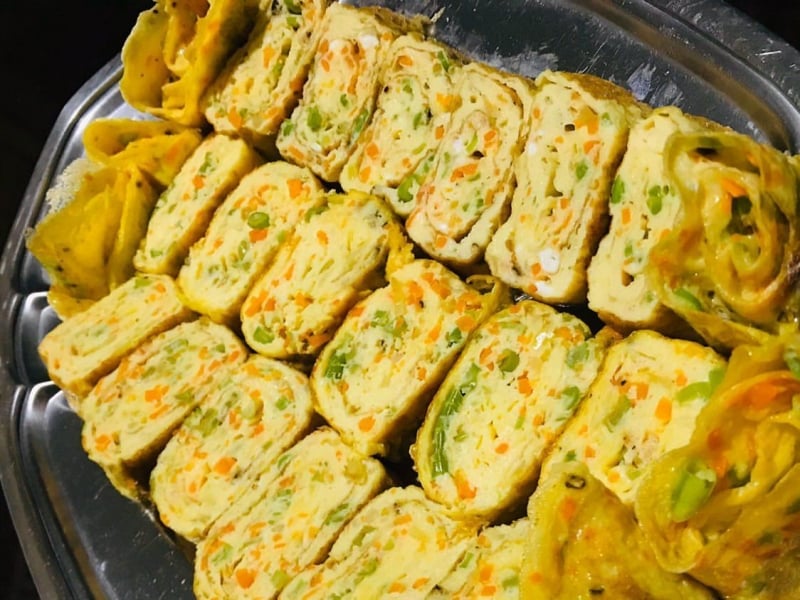
The Gyeran Mari that my dad cooked at home.
Might as well kickstart this list with the lunch box favourite that I just mentioned! Gyeran Mari is an egg roll or rolled omelette that usually features two types of finely chopped veggies; it’s a mainstay in the typical Korean lunch box meal set. This is why so many kids in South Korea grow up loving this egg speciality!
If you truly paid attention to Boys Over Flowers, you’ll know Geum Jan-di makes a creative lunch set for Gu Jun-pyo (Lee Min-ho fans, where you at?!) — which includes Gyeran Mari. Since Gyeran Mari is also a popular banchan or side dish that accompanies Korean barbecues and stews, it remains a favourite even beyond primary school.
Also read: Korean Cuisine: The Beginner’s Guide to Banchan!
Gyeran Mari is typically cooked with scallions and carrots, giving the soft egg roll more flavour, texture, and colour. The good news is that you can make it at home, just like my dad did! But don’t let the seemingly simple dish fool you. You’ll have to master the technique of rolling the egg so that it looks good enough for Instagram! #ChallengeAccepted
2. Gyeran Jjim
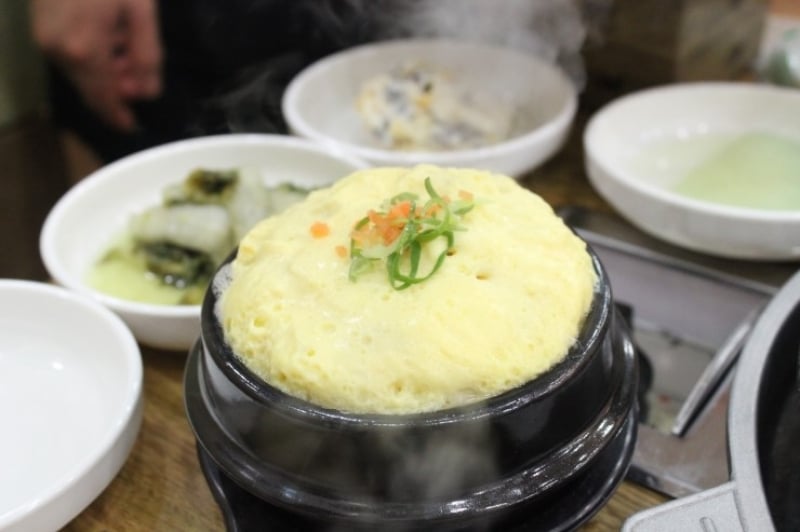
Image credit: letter001
From its title alone, you can already tell that the K-drama series Let’s Eat delves into the wondrous world of food. Those who’ve seen all three seasons will surely attest to the show’s mouthwatering quality. After all, the production is heavily peppered with mukbang-like scenes and exaggerated “beauty shots” of Korean dishes.
In case you didn’t know, mukbang (also meokbang) is a pop culture movement that was popularised in South Korea around 2010. It’s essentially a live streaming of a person or a group gorging on an ungodly amount of food. Combine this strange phenomenon with a slice-of-life plot that focuses on relationships, and you’ve got Let’s Eat.
This series is also where K-pop idol Yoon Doo-joon played gourmand Goo Dae-young. Who could ever forget Dae-young’s top formula for cooking flavourful Korean Shabu-shabu: meat-vegetable-meat! While the show brims with more elaborate Korean dishes, I turn to Let’s Eat to introduce yet another popular banchan: the Gyeran Jjim or steamed egg casserole.
In one of the first season’s episodes, leading lady Lee Soo-kyung can be seen heartily savouring Gyeran Jjim by the spoonful. Lovers of gui or any Korean speciality that’s grilled (like Samgyeopsal) will know Gyeran Jjim’s fluffy goodness well. It really is like eating a warm cloud made of egg! Gyeran Jjim is traditionally cooked and served in a tukkbaegi, a clay pot that’s often seen containing different kinds of banchan. When you open a tukkbaegi and see a poof of light yellow rising from it, you can be sure that it’s one heaping serving of Gyeran Jjim!
3. Kimchi
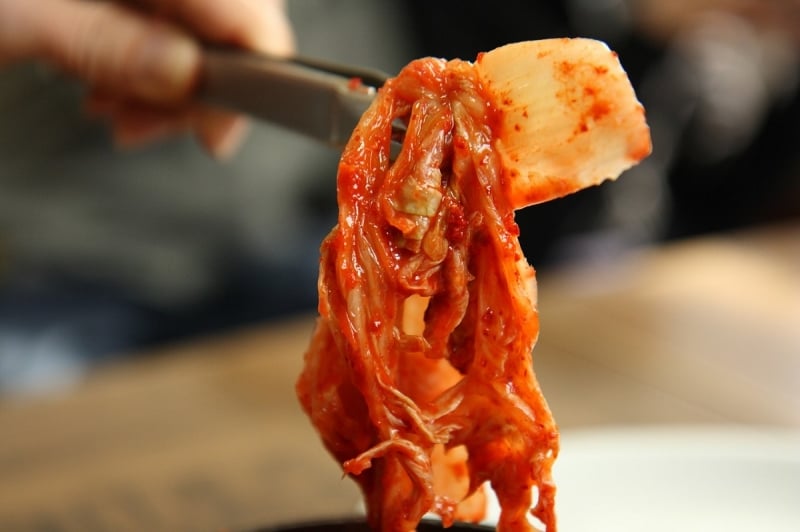
While I’m on the topic of banchan or Korean side dishes, let me give a shoutout to the king of all banchan — Kimchi! I don’t even need to cite a specific K-drama series to prove the “quintessential-ness” of this lacto-fermented side dish. It can be seen almost everywhere; think of it as the Korean sauerkraut! I’m sure most of you have tasted it.
Kimchi is traditionally made with a type of cabbage that’s locally called Baechu. You’ll see Sam-soon in My Name Is Kim Sam-soon, another food-centred K-drama series, eating her meals with tubs of homemade Kimchi. In the Reply series, beloved characters often munch on Kimchi as a midday snack enjoyed with boiled sweet potatoes. If you’re looking for new ways to chow down on South Korea’s national dish, you might want to pair it with this tuber crop. They say the flavours complement each other, plus you’ll be eating healthy!
4. Fish Sausage Jeon
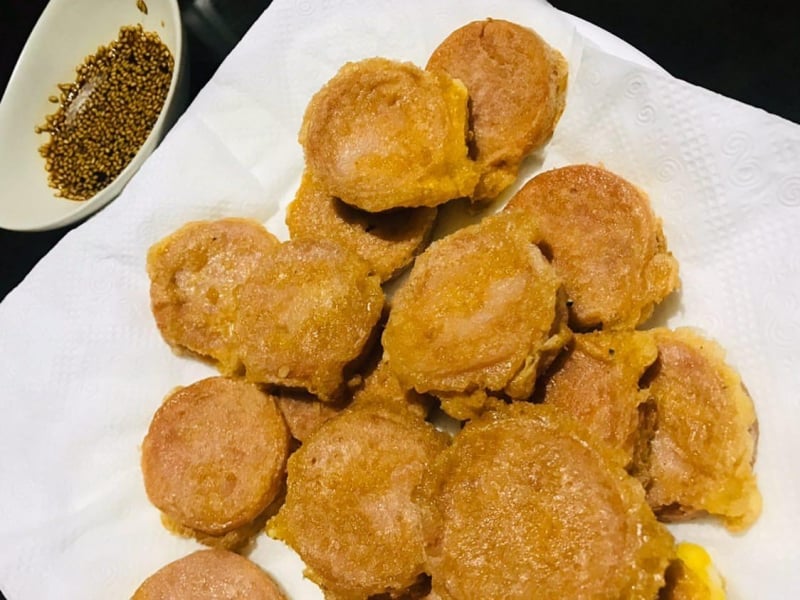
The Fish Sausage Jeon we eat at home.
Another ‘lunch box staple’, the Fish Sausage Jeon is considered a childhood treat for many South Koreans. Like the Gyeran Mari, it also makes its way to adult set meals as banchan. Fish sausage is pretty popular in Korea. The meat alternative is so friendly to the palate that even the pickiest eaters find themselves snacking away on them — which is why it’s a hit with kids.
While the nostalgic dish brings many back to their younger years, it is now somehow considered old-school as other variants have emerged in popular Korean cuisine. But it’s good to get acquainted with the OG: Fish Sausage Jeon or fish sausage dipped in egg and flour.
If you watched Reply 1988, you would know that the other kids once made fun of Sun-woo (played by Go Kyung-pyo) because of this dish. Sun-woo’s mother, whose lacklustre cooking skills have become an inside joke, somehow made Fish Sausage Jeon taste off. And, as they say, it’s almost impossible to make Korean sausage taste bad. They’re that good. Go ahead, grab some fish sausage from your nearest Korean mart and see for yourself. Don’t forget to dip them in egg and flour!
5. Tteokbokki
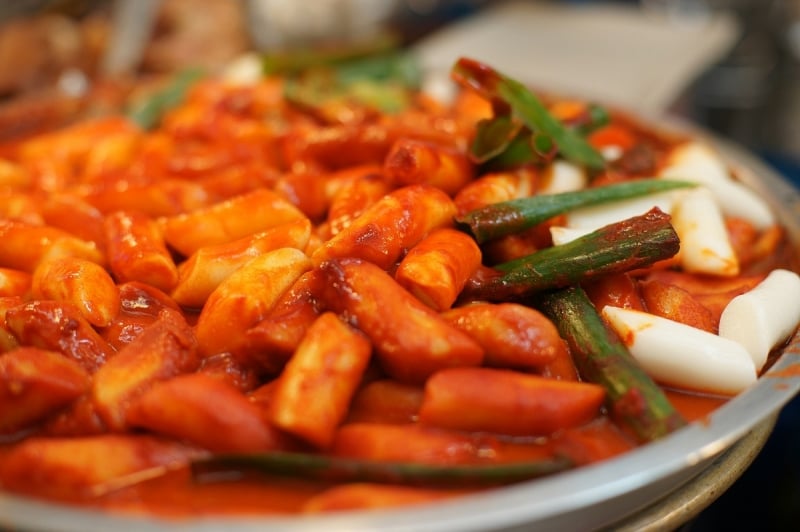
Image credit: Popo le Chien
With no particular K-drama series in mind, this next entry will still surely ring bells! Tteokbokki or spicy rice cakes is a popular street food you’ll see everywhere in Korea. It then makes sense that it’s among the tasty morsels we often spot in Korean shows, whether with other Korean dishes, as a standalone snack, or as barchow.
I’m reminded of the Subak-hwachae or watermelon punch that Kim Mi-so whipped up in What’s Wrong With Secretary Kim while on a seaside holiday. Although it’s not spiked, I imagine the refreshing drink pairs well with Tteokbokki’s signature bite.
6. Korean Barbecue
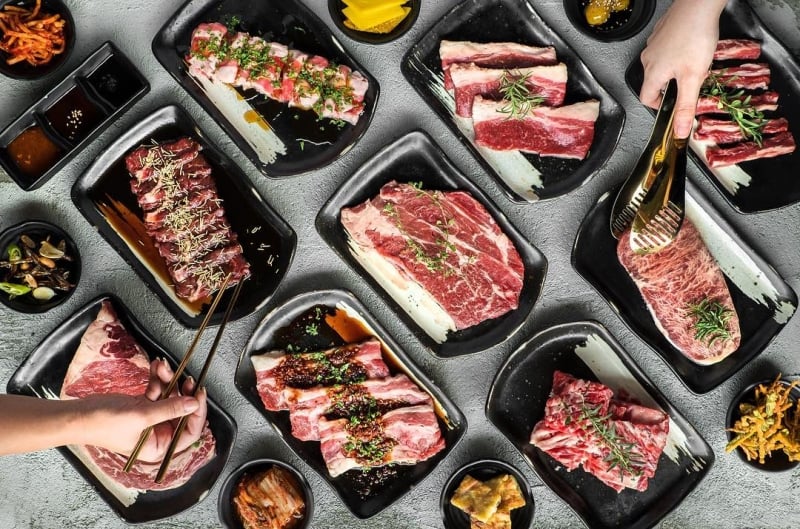
Image credit: Geonbae Modern Korean Bar & Grill Official Facebook Page
Many beloved Korean dramas feature iconic food clips but I daresay Kim Bok-joo’s top Korean Barbecue technique takes the cake. In the scene, the ever-adorable Bok-joo teaches her weightlifting teammates the best way to eat a full Korean Barbecue course.
First, you eat all the grilled meat — plain meat first before marinated slices. Feel free to wrap them in greens if that’s your thing. Next up would be fried rice; eat it while it’s hot! Last but not least, tie it all together with a bowl of cold glass noodles. In the Philippines, where I’m from, we add another step: dessert! Go for any Korean ice cream that’s available.
Now, you should know that Korean Barbecues feature a wide range of meat options and cuts. On that note, samygyeopsal doesn’t translate to Korean Barbecue — in case you didn’t know. It’s actually pork belly slices, one of the meat specialities offered in Korean Barbecue courses. We highly recommend trying all meat cuts so that you can have the full K-BBQ experience!
7. Korean Fried Chicken
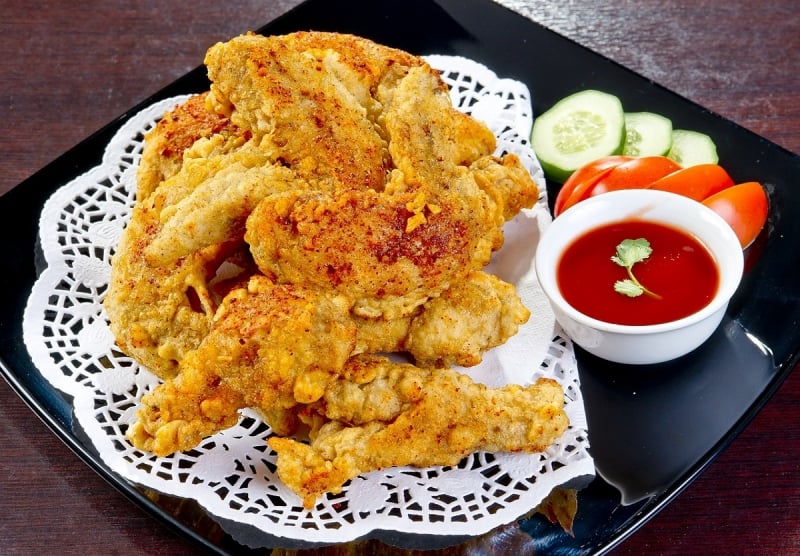
In terms of iconic Korean food standing, Korean Fried Chicken is equal in rank to Korean Barbecue. The dish is pretty straightforward: It’s fried chicken, but prepared in such a way that makes it unique. First of all, Korean Fried Chicken is typically seasoned with soy sauce, but there are many flavours to choose from like garlic and honey. The skin of Korean Fried Chicken is also thin and very crispy, so it definitely adds crunch to the entire meal.
Some people have Korean fried chicken with rice, some with banchan of their choosing. Others just wing it and devour it on its own by hand — just like Lee Min-ho’s character did in the new series, The King: Eternal Monarch. Plus points to whoever can identify which character served Korean Fried Chicken to the dashing Capt. Ri in South Korea, in the hit series Crash Landing On You!
Also read: Watch Hyun Bin All Day: Here’s A List Of All His Netflix Shows!
My very good friend Lester, who stays in South Korea for long-term travel, taught me how to wash Korean Fried Chicken down with somaek. It’s a Korean cocktail made of beer and soju. If you’re one to enjoy a nice buzz, this should be one of your go-to drinks. It’s easy to make, plus it’s very affordable. Geonbae!
8. Kimchi-bokkeum-bap
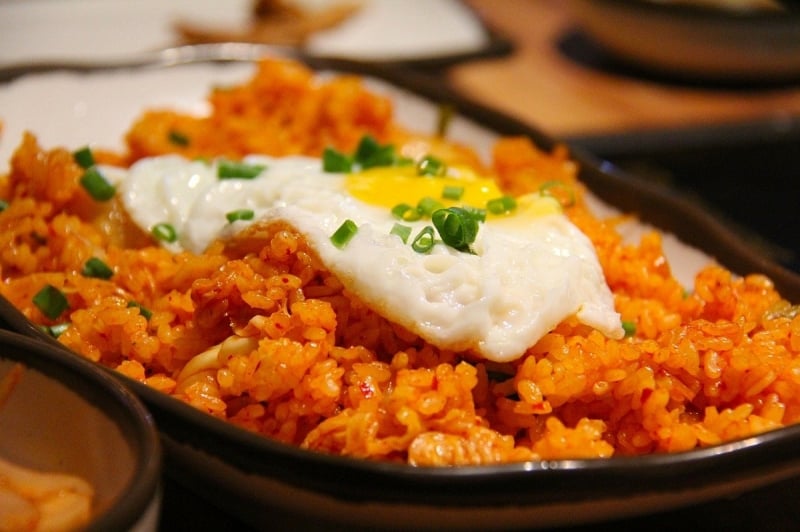
I’m sure you know this entry by its English name, Kimchi Fried Rice. This is another one of those Korean dishes that you just see everywhere, even onscreen, because it’s paired with other specialities. It’s prepared like any other fried rice dish — by stir-frying ingredients in with the rice. Of course, for Kimchi-bokkeum-bap, the star is kimchi. Koreans mix in other ingredients like minced meat and vegetables when they’re available, but one topping is a mainstay: fried egg.
Do you recall when Ae-ra made Korean Fried Rice for Dong-man in Fight For My Way? If you’re stuck at home right now and have some ingredients to spare, why not make the same Kimchi-bokkeum-bap for your loved ones? Don’t forget to draw a heart with some good ol’ ketchup!
9. Sundae
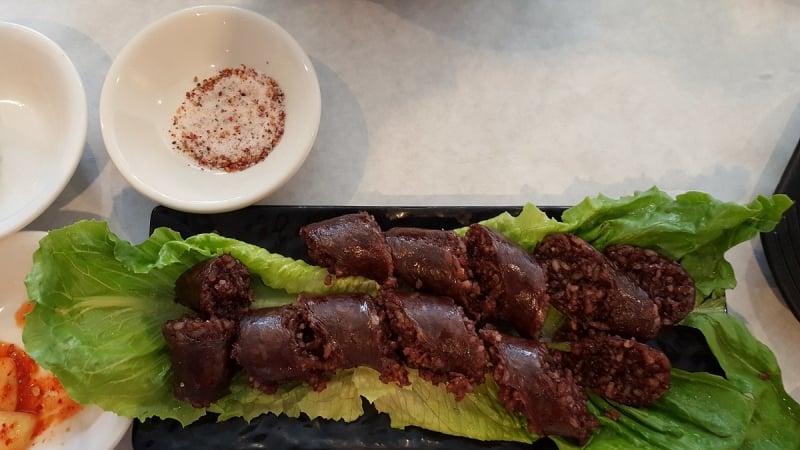
Image credit: Tim Evanson
Speaking of Fight For My Way (FFMY), here’s another interesting snack you can add to your food bucket list that was featured in the same K-drama series. It’s for the more daring foodie and nope, I’m pretty sure this isn’t the type of sundae you’re used to. In Korea, Sundae isn’t soft serve ice cream — it’s a type of blood sausage.
They say it’s as flavourful as it is healthy; it’s certainly packed with iron since it’s made of blood and cow or pig innards that are then stuffed into the same animal’s intestines! That might not sound appetising, but Sundae is well-loved street food in both the North and the South.
Now back to FFMY. In case you need reminding, aside from running a gym, Dong-man’s coach (Hwang Jang-ho) also had a food truck business that mainly sold Korean sausages and assorted meat. You guessed it, Sundae was on the menu!
10. Bibimbap
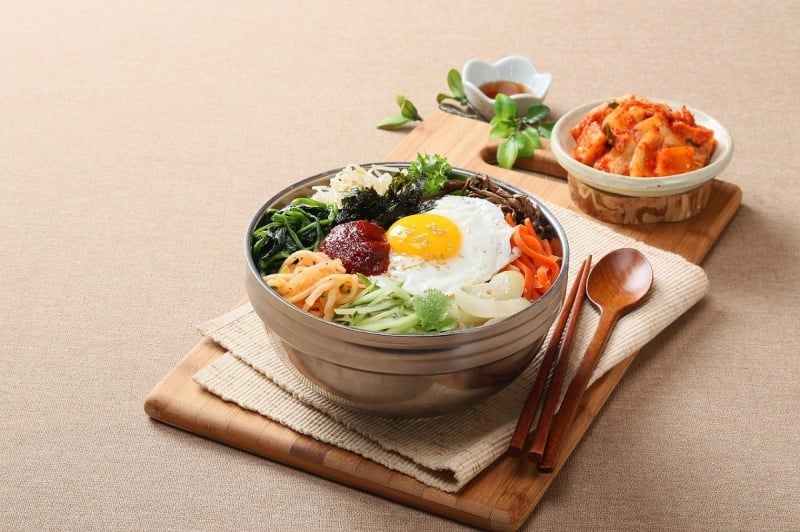
Here’s a major throwback: Song Hye-kyo in Full House! Fans of the series know how big an appetite Hye-kyo’s character, Han Ji-eun, had. She was often filmed eating, at home and even aboard an aeroplane. One of the most memorable Korean dishes she was seen gobbling down in the series was Bibimbap, which some would say is a more filling version of Kimchi-bokkeum-bap.
Simply put, Bibimbap is a rice topping dish. It’s served steaming, with a variety of ingredients such as fried egg, namul (sautéed vegetables), assorted meat, and gojuchang (chili paste). It can also contain doenjang, a paste made from fermented soybeans.
11. Bungeoppang
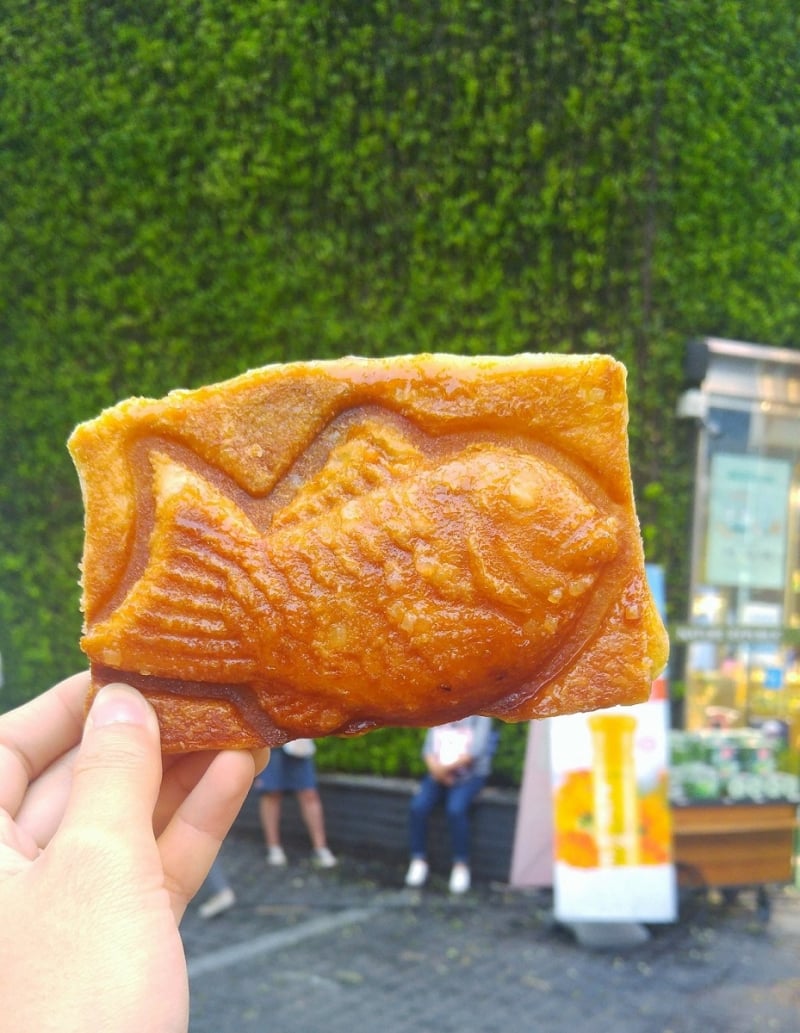
Image credit: ktchang16
There are a couple of Korean dramas that highlight the adorable Bungeoppang, a fish-shaped pastry filled with sweet red bean paste. But we have to admit, it figured more prominently in another Lee Min-ho series, Legend of the Blue Sea. The fish pastry’s cameo was fitting too since Legend of the Blue Sea’s female protagonist is a mermaid! This sugary treat is normally served warm, so it’s perfect for Korea’s wintry months.
Those living in the tropics might want to go for its chilled, ready-to-eat counterpart, the fish-shaped ice cream Binggrae Samanco. Filled with vanilla ice cream and sweet red bean paste, it’s certainly a cute and tasty way to cool down!
12. Petrol Clams
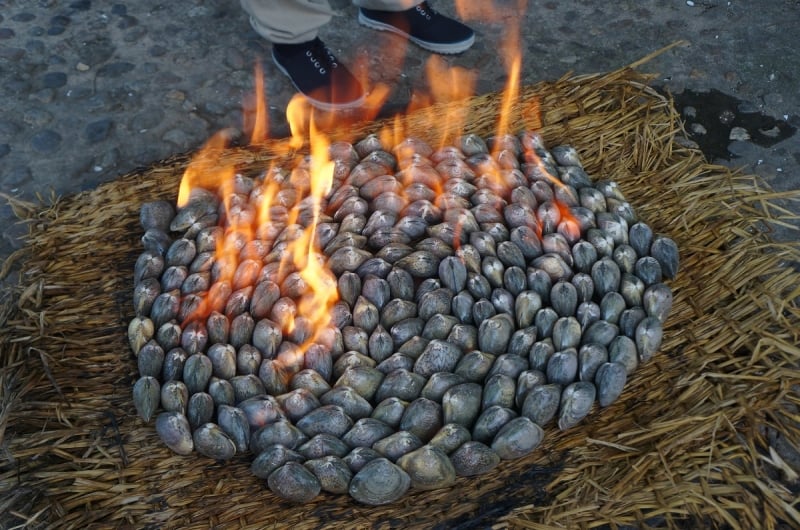
Image credit: Uri Tours
I think we can all agree that the Korean series Crash Landing On You (CLOY) took the world by storm. It also gave viewers a genuine peek into the nuances of North Korean culture. And according to reports, this is all thanks to one of CLOY’s writers — Kwak Moon-wan, who defected from the North years ago.
But let’s zero in on the food. There’s a scene in CLOY where Capt. Ri and his men teach Yoon Se-ri to eat Petrol Clams, a North Korean delicacy where grilled clams are cooked by dousing them with petrol as the shellfish sit above the flames. The cherry on top is bottles upon bottles of soju. No, not for pouring on the clams; it’s for drinking while munching on clams’ chewy flesh.
They say the chemical reaction of the burning petrol makes the clams even tastier, and the soju’s sweetness perfectly pairs with this distinct flavour. Of course, in the South, they grill clams and other seafood, and wash it down with soju too — but sans the petrol.
13. Jajangmyeon
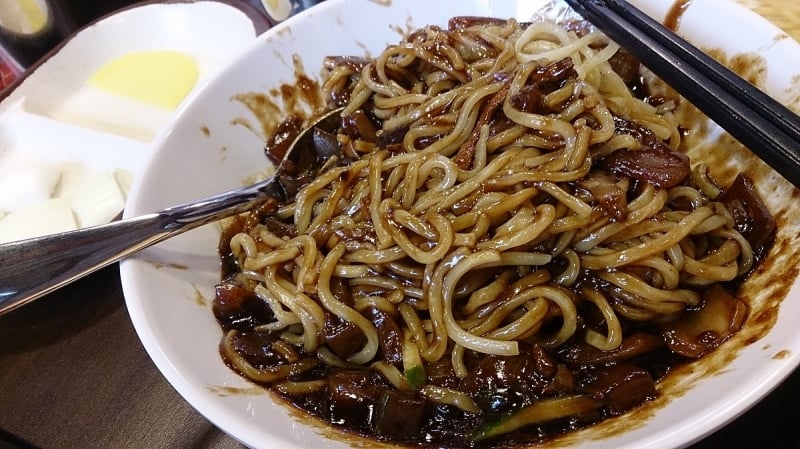
Image credit: ProjectManhattan
Coffee Prince fans, make some noise. I have many reasons for loving this oldie-but-goodie: coffee, Gong Yoo, among others. But I can’t deny I liked this series too because it was practically overflowing with delicious-looking Korean dishes! But out of all the food that boyish Go Eun-chan scarfed down, one dish stuck with me the most. It was from the scene where she won in a Jajangmyeon-eating contest against her sister’s suitor, played by the late Korean actor and model, Lee Eon.
If you’re having trouble recalling that scene, it’s where Eun-chan eats a whole lotta black noodles. Those bowls were, in fact, filled with Jajangmyeon — a thick noodle dish made tasty by its signature black bean sauce. Yum!
14. Kimbap
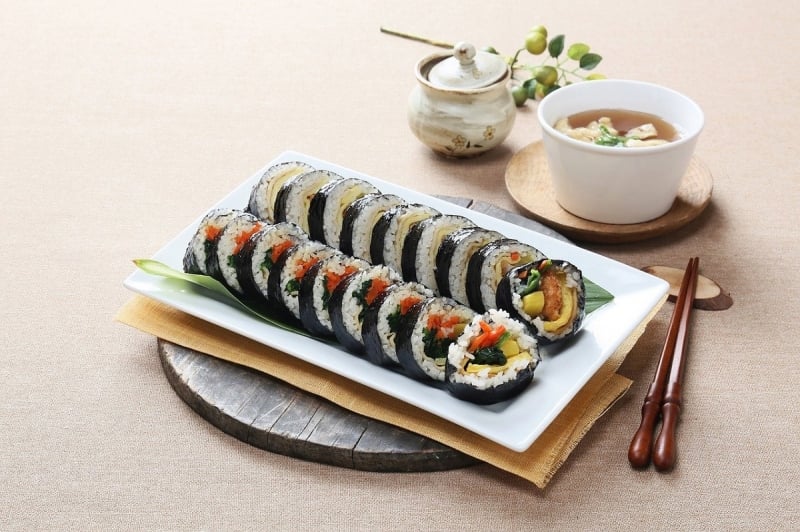
Followers of the 2014 series Healer would know that if there’s a Korean speciality that’s almost synonymous with the show, it’s Kimbap. Motherly Jo Min-ja, after all, was so obsessed with making these Korean sushi rolls!
Like the Japanese sushi, Kimbap are rolls of sticky rice and vegetables held together by dried seaweed. They can also include your choice of meat. My personal favourite is tuna Kimbap! These rolls are then cut into smaller, bite-sized pieces ideal for snacking or for packing a light meal.
15. Sundubu-jjigae
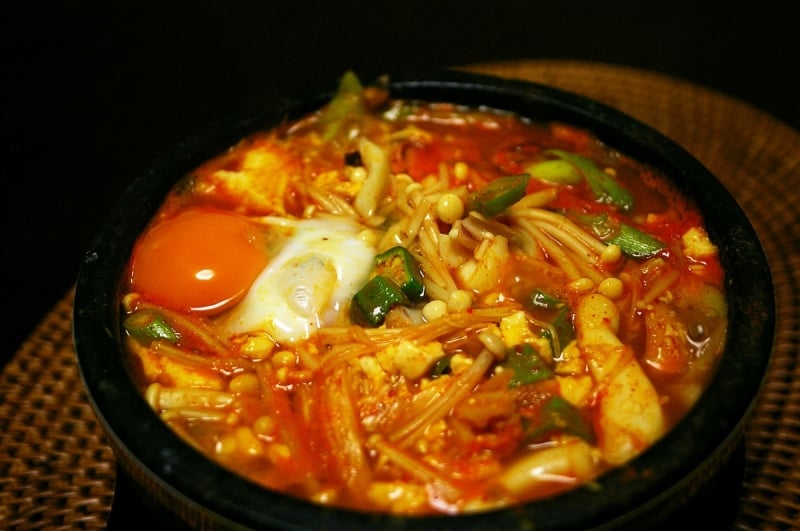
Image credit: titanium22
Since he enjoyed it so much with his father, Park Seo-joon’s character in Itaewon Class had Spicy Tofu Stew at the top of his comfort food list. And since it’s a pretty new series, I won’t be resorting to spoilers but you should know that this dish made it to some of the show’s most memorable scenes.
Also read: Chill With Park Seo-joon: Here Are All His Netflix Shows!
In Korea, this thick, spicy soup is called Sundubu-jjigae. It’s slow-cooked with anchovy stock, radish, dried kelp, kimchi, and of course, soft tofu. Some also throw in pork belly slices and assorted meat for good measure. As Park Sae-ro-yi and his father did, it’s best to slurp on this soup with a trusty bottle of soju nearby — especially if you’re having a bad day.
And as Sae-ro-yi’s dad said, if your soju tastes sweeter than normal, then that means you must have had a “really good day”, which could also mean you had the worst day ever. *Sigh*, I’ll save all my ~feels before I reveal too much.
Bonus: Ramyeon, Samyang, and Chapaguri
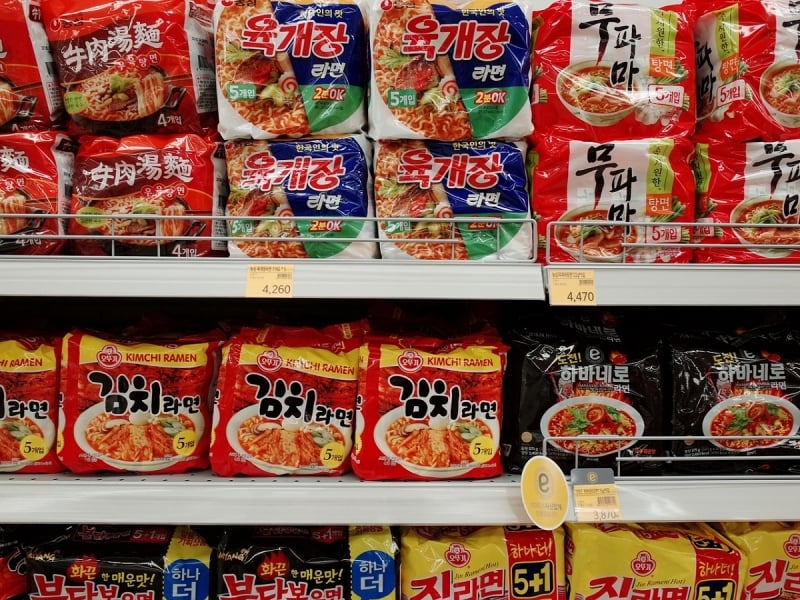
What’s popular Korean cuisine without all the instant noodles we’ve seen onscreen, whether through K-drama series or must-watch movies? From CLOY and What’s Wrong With Secretary Kim to Descendants of the Sun and the entire Reply series, there’s Ramyeon or instant ramen! The #NSFW joke goes, only intimate couples can share a serving of Ramyeon in private quarters. So this is something you might want to have with your SO!
All over Youtube and social media, Samyang — an instant noodle brand known for its intense Scoville level (that means it’s super spicy!) — has reached viral status. The challenge is to finish an entire pack (or more, if you can) of the infamous “fire noodles” without pausing for a drink. You drink, you lose.
Last but not least, there’s the iconic Chapaguri or Ram-don from the award-winning film, Parasite. To make this at home, you’ll have to get your hands on two kinds of Korean instant noodles: The spicy kelp-flavoured Neoguri and Jjapaghetti, the latter being an add-hot-water-only version of black bean noodles. Mix the two after cooking, top with juicy chunks of pan-fried sirloin or rib-eye, and voila — Parasite Ram-don!
Phew! That was a mouthful, so to speak. But now I’m famished and it’s time to eat my dad’s home-cooked Gyeran Mari. Here’s a photo to whet your appetite and maybe encourage you to whip up these Korean dishes yourself:
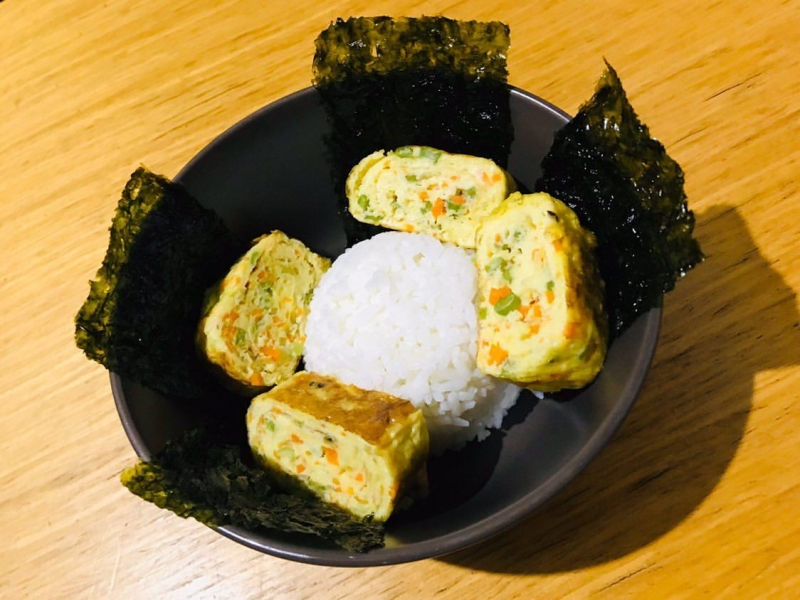
Here’s our Gyeran Mari, plated with dried seaweed laver!
Looks good, right? Meokja! That’s the most common way of saying, “Let’s eat!” in Korean, if I’m not mistaken. Or at least that’s what I’ve been hearing in my steady diet of K-dramas.




